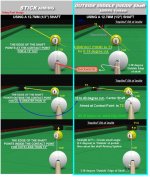STICK Aiming
This is not an "exact" system, so I'll add a little introduction:
Because of its fixed width, the edge of a centered shaft points directly at the OB contact point for only one cut angle. For a 12.7mm shaft like the one in the pictures below this "Stick Aiming cut angle" is 13 degrees. The "Stick Aiming cut angle" for smaller shafts is a smaller angle and for larger shafts it's a larger angle.
Stick Aiming is done by learning how the edge of your stick lines up compared to the OB contact point for different cut angles and recreating the correct alignment from memory for each shot that comes up. The edge of the stick almost never (except for the shaft's one Stick Aiming cut angle) lines up exactly with the OB contact point, but using it as a fixed comparison for any cut angle can be a helpful memory aid.
Like other "reference" systems, Stick Aiming can be used with varying degrees of awareness of how it functions:
- "consciously", with real time awareness of estimations being made
- "subconsciously", with abstract understanding that estimations are made
- "unconsciously", with no awareness that estimations are made (believing the method is "exact" for all shots)
pj
chgo
View attachment 256067
NOTE:
Another version of Stick Aiming compares the stick's edges and center with the OB's edges and fractions.
